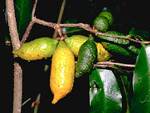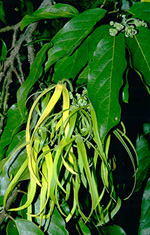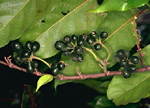 |
This is a large, primitive, pantropical family. In Australia, members of the family are restricted to rainforests and vine scrubs of eastern Queensland and the Top End of the Northern Territory.
Characteristic features of the family Annonaceae in Australia include: - trees, shrubs or climbers
- flowers often dark-coloured and fruity-scented flowers (often pollinated by beetles), with whorled or spirally-arranged perianth parts and many, spirally arranged stamens and free carpels
- fruits usually comprising a cluster of fleshy, often brightly-coloured and sausage-shaped fruitlets
Description
Evergreen, deciduous or semi-deciduous trees, or shrubs, or woody vines climbing by hooks, twining or scrambling stems. Internal secretions of essential oils. Plants glabrous or with simple or stellate, non-glandular, uniseriate hairs or peltate scales. Leaves distichous or spiral, petiolate. Stipules absent. Lamina simple, symmetric or conspicuously asymmetric, dorsiventral; lanceolate, ovate, elliptic, oblanceolate, obovate or oblong; base cuneate, cordate, attenuate, rounded or oblique; margins entire, ±flat, revolute or recurved; venation pinnate, with the midrib conspicuous, and the tertiary venation reticulate; surfaces pellucid-punctate; herbaceous, leathery, membranous or papery. Domatia absent or consisting of pits, pockets or hair tufts in the vein angles. Male and female flowers occurring on separate plants, or with bisexual flowers and either male or female flowers occurring on the same plant, or with bisexual flowers and both male and female flowers occurring on the same plant, or with all the flowers bisexual. Inflorescences terminal, axillary, leaf opposed, intercalary, cauliflorous or ramiflorous, consisting of cymes or solitary flowers. Bracts present. Bracteoles ?absent. Pollination by insects. Flowers fragrant or malodorous; stalked. Floral disc absent; nectaries absent, or present on the perianth. Perianth regular, of at least 2 dissimilar whorls, imbricate, valvate or open in bud. Calyx segments fused, with 3 lobes; calyx cup-shaped, herbaceous. Corolla segments free or fused, with 6 segments or lobes, with no clear relationship to the calyx lobes; corolla cup-shaped or bell-shaped, cream, yellow, orange, red, green, grey, brown or black, without contrasting markings, or streaked, spotted, etc, membranous or papery; claws present or absent; lobes ±entire. Fertile stamens numerous, not clearly correlated with the calyx lobes, free of the corolla, free of the ovary and style, distinct from each other, all ±equal. Staminodes present. Staminal filaments short. Anthers not versatile, opening outwards or sideways by longitudinal slits; 2-celled; with apical appendages. Ovary superior and sessile or stalked. Carpels 3–25, free. Style absent and the stigma terminal and ±sessile on the ovary. Ovules1–10 per locule, stalked; placentation basal or parietal. Fruit fleshy, indehiscent; a cluster of stipitate berries (camaretum), or rarely a single aggregate fleshy fruit (syncarpium), or a schizocarp forming mericarps or rarely nutlets; the perianth on the maturing fruit deciduous or dry and persistent. Disseminule micro-surface ±smooth, yellow, orange, red or black, glossy or dull. Seeds 1–20 per fruit. Aril present or absent. Cotyledons 2. Embryo ?shapeless.
(Note: this description has been generated from the coded data compiled for the key. Any errors in the key data will be reflected in the descriptions.)
A treatment of the family Annonaceae has not yet been published in the Flora of Australia. It will appear in Volume 2.
Australian genera of Annonaceae (as recognised for the Flora of Australia)
Ancana
Annona
Cananga
Cyathostemma
Desmos
Fissistigma
Fitzalania
Goniothalamus
Haplostichanthus
Melodorum
Miliusa
Mitrephora
Polyalthia
Polyaulax
Popowia
Pseuduvaria
Rauwenhoffia
Uvaria
Xylopia

|
  |

Ancana stenopetala (flower)
Photo: P.Ollerenshaw © ANBG

Ancana stenopetala (fruits)
Photo: D.Jones © D.Jones

Cananga odorata (flowers)
Photo: H.Nicholson © H. & N. Nicholson

Cananga odorata (fruits)
Photo: M.Fagg © M.Fagg

|

| |